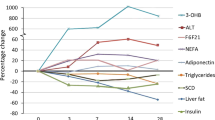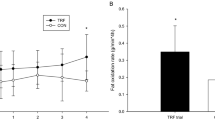Abstract
OBJECTIVE: Medium-chain triglyceride (MCT) consumption has been shown to increase energy expenditure (EE) and lead to greater losses of the adipose tissue in animals and humans. The objective of this research was to examine the relationship between body composition and thermogenic responsiveness to MCT treatment.
DESIGN: Randomized, crossover, controlled feeding trial, with diets rich in either MCT or long-chain triglyceride (LCT) (as olive oil) for periods of 4 weeks each.
SUBJECTS: A total of 19 healthy overweight men aged (x±s.e.m.) 44.5±2.5 y with a body mass index of 27.8±0.5 kg/m2.
MEASUREMENTS: EE and body composition were measured using indirect calorimetry and magnetic resonance imaging, respectively, at the baseline and end point of each feeding period. EE was measured for 30 min before consumption of a standard meal and for 5.5 h following the meal.
RESULTS: Body weight (BW) decreased (P<0.05) by 1.03±0.25 kg with MCT consumption compared to 0.62±0.29 kg with LCT consumption. The difference in average EE between MCT and LCT consumptions was related to initial BW, such that men with lower initial BW had a greater rise in EE with MCT consumption relative to LCT on day 28 (r=−0.472, P=0.04) but not day 2 (r=−0.368, P=0.12). Similar results were obtained with fat oxidation on day 28 (r=−0.553, P=0.01). The greater rise in fat oxidation with MCT compared to LCT consumption on day 2 tended to be related to greater loss of BW after MCT vs LCT consumption (r=−0.4075, P=0.08).
CONCLUSION: These data suggest that shunting of dietary fat towards oxidation results in diminished fat storage, as reflected by the loss of BW and subcutaneous adipose tissue. Furthermore, MCT consumption may stimulate EE and fat oxidation to a lower extent in men of greater BW compared to men of lower BW, indicative of the lower responsiveness to a rapidly oxidized fat by overweight men.
This is a preview of subscription content, access via your institution
Access options
Subscribe to this journal
Receive 12 print issues and online access
$259.00 per year
only $21.58 per issue
Buy this article
- Purchase on Springer Link
- Instant access to full article PDF
Prices may be subject to local taxes which are calculated during checkout




Similar content being viewed by others
References
Flegal KM, Carroll MD, Ogden CL, Johnson CL . Prevalence and trends in obesity among US adults, 1999–2000. JAMA 2002; 288: 1723–1727.
Brownell KD, Jeffrey RW . Improving long-term weight loss: pushing the limits of treatment. Behav Ther 1987; 18: 353–374.
Hensrud DD . Dietary treatment and long-term weight loss and maintenance in type 2 diabetes. Obes Res 2001; 9 (Suppl 4): 349S–353S.
Anderson JW, Konz EC, Frederich RC, Wood CL . Long-term weight-loss maintenance: a meta-analysis of US studies. Am J Clin Nutr 2001; 74: 579–584.
Babayan VK . Medium chain triglycerides and structured lipids. Lipids 1987; 22: 417–420.
Bach AC, Babayan VK . Medium-chain triglycerides: an update. Am J Clin Nutr 1982; 36: 950–962.
Bendixen H, Flint A, Raben A, Hoy CE, Mu H, Xu X, Bartels EM, Astrup A . Effect of 3 modified fats and a conventional fat on appetite, energy intake, energy expenditure, and substrate oxidation in healthy men. Am J Clin Nutr 2002; 75: 47–56.
Dulloo AG, Fathi M, Mensi N, Girardier L . Twenty-four-hour energy expenditure and urinary catecholamines of humans consuming low-to-moderate amounts of medium-chain triglycerides: a dose–response study in a human respiratory chamber. Eur J Clin Nutr 1996; 50: 152–158.
Hill JO, Peters JC, Yang D, Sharp T, Kaler M, Abumrad NN, Greene HL . Thermogenesis in humans during overfeeding with medium-chain triglycerides. Metabolism 1989; 38: 641–648.
Scalfi L, Coltorti A, Contaldo F . Postprandial thermogenesis in lean and obese subjects after meals supplemented with medium-chain and long-chain triglycerides. Am J Clin Nutr 1991; 53: 1130–1133.
Seaton TB, Welle SL, Warenko MK, Campbell RG . Thermic effect of medium-chain and long-chain triglycerides in man. Am J Clin Nutr 1986; 44: 630–634.
St-Onge M-P, Bourque C, Jones PJH, Ross R, Parsons WD . Medium- versus long-chain triglycerides for 27 days increases fat oxidation and energy expenditure without resulting in changes in body composition in overweight women. Int J Obes 2003; 27: 95–102.
White M, Papamandjaris AA, Jones PJH . Enhanced postprandial energy expenditure with medium-chain fatty acid feeding is attenuated after 14 d in premenopausal women. Am J Clin Nutr 1999; 69: 883–889.
St-Onge M-P, Ross R, Parsons WD, Jones PJH . Consumption of a functional oil containing medium chain triglycerides by overweight men increases energy expenditure and decreases body adiposity compared to a diet rich in olive oil. Obes Res 2003; 11: 395–402.
Tsuji H, Kasai M, Takeucchi H, Nakamura M, Okazaki M, Kondo K . Dietary medium-chain triacylglycerols suppress accumulation of body fat in a double-blind, controlled trial in healthy men and women. J Nutr 2001; 131: 2853–2859.
Mifflin MD, St-Jeor ST, Hill LA, Scott BJ, Daugherty SA, Koh YO . A new predictive equation for resting energy expenditure in healthy individuals. Am J Clin Nutr 1990; 51: 241–247.
Bell L, Jones PJH, Telch J, Clandinin MT, Pencharz PB . Prediction of energy needs for clinical studies. Nutr Res 1985; 5: 123–129.
Reed GW, Hill JO . Measuring the thermic effect of food. Am J Clin Nutr 1996; 63: 164–169.
Lusk G . The elements of the science of nutrition. WB Saunders Co.: Philadelphia; 1928.
Binnert C, Pachiaudi C, Beylot M, Croset M, Cohen R, Rion JP, Laville M . Influence of human obesity on the metabolic fate of dietary long- and medium-chain triacylglycerols. Am J Clin Nutr 1998; 67: 595–601.
Ferraro RT, Eckel RH, Larson DE, Fontvieille AM, Rising R, Jensen DR, Ravussin E . Relationship between skeletal muscle lipoprotein lipase activity and 24-hour macronutrient oxidation. J Clin Invest 1993; 92: 441–445.
Bach AC, Ingenbleek Y, Frey A . The usefulness of dietary medium-chain triglycerides in body weight control: fact or fancy? J Lipid Res 1996; 37: 708–726.
St-Onge M-P, Ross R, Jones PJH . Medium chain triglyceride consumption for 28 days improves blood lipid profile, increases energy expenditure, and leads to smaller body fat compartments compared to olive oil consumption in overweight men. Circulation 2002; 106 (Suppl II): II-742.
Bourque C, St-Onge M-P, Papamandjaris AA, Cohn JS, Jones PJH . Consumption of a functional oil composed of medium chain triacylglycerols, phytosterols and n-3 fatty acids improves the overall cardiovascular risk profile of overweight women. Metabolism 2003; 52: 771–777.
Sevenhuysen GP, Fieldhouse P, Young TX, McNeil C, Gelskey DE, McDonald SM . The Manitoba Nutrition Survey: fat consumption data. Can J Pub Health 1993; 84: 389–393.
Hyvonen L, Lampi AM, Varo P, Kavistoinen O . Fatty acid analysis, TAG equivalents as net fat value, and nutritional attributes of commercial fats and oils. J Food Compos Anal 1993; 6: 24–40.
Acknowledgements
We would like to acknowledge the excellent work from the staff of the Mary Emily Clinical Nutrition Research Unit for assistance in meal preparation. Funding was provided by Dairy Farmers of Canada and Forbes Medi-Tech Inc.
Author information
Authors and Affiliations
Corresponding author
Rights and permissions
About this article
Cite this article
St-Onge, MP., Jones, P. Greater rise in fat oxidation with medium-chain triglyceride consumption relative to long-chain triglyceride is associated with lower initial body weight and greater loss of subcutaneous adipose tissue. Int J Obes 27, 1565–1571 (2003). https://doi.org/10.1038/sj.ijo.0802467
Received:
Revised:
Accepted:
Published:
Issue Date:
DOI: https://doi.org/10.1038/sj.ijo.0802467
Keywords
This article is cited by
-
Virgin Coconut Oil (VCO) Ameliorates High Fat Diet (HFD)-Induced Obesity, Dyslipidemia and Bestows Cardiovascular Protection in Rats
Proceedings of the National Academy of Sciences, India Section B: Biological Sciences (2022)
-
High-throughput lipidomic profiling of high-density lipoprotein from egg yolk (EYHDL): comparison based on UPLC-MS/MS and GC–MS
European Food Research and Technology (2019)
-
Are We Going Nuts on Coconut Oil?
Current Nutrition Reports (2018)
-
They say coconut oil can aid weight loss, but can it really?
European Journal of Clinical Nutrition (2017)
-
Medium‐Chain Enriched Diacylglycerol (MCE‐DAG) Oil Decreases Body Fat Mass in Mice by Increasing Lipolysis and Thermogenesis in Adipose Tissue
Lipids (2017)



